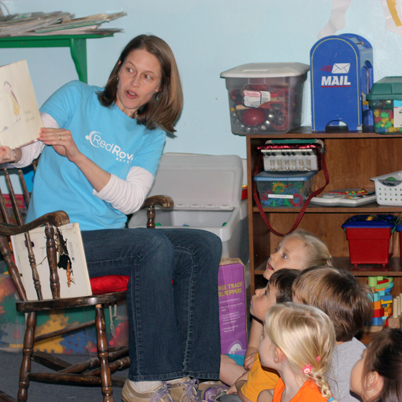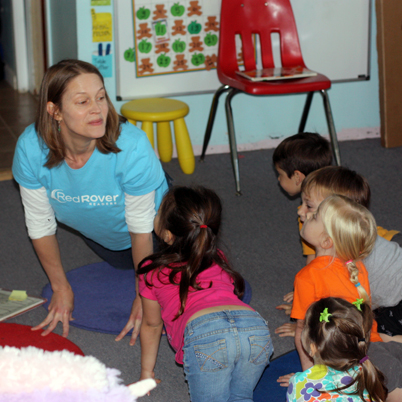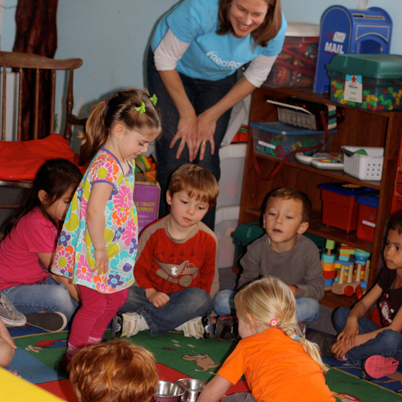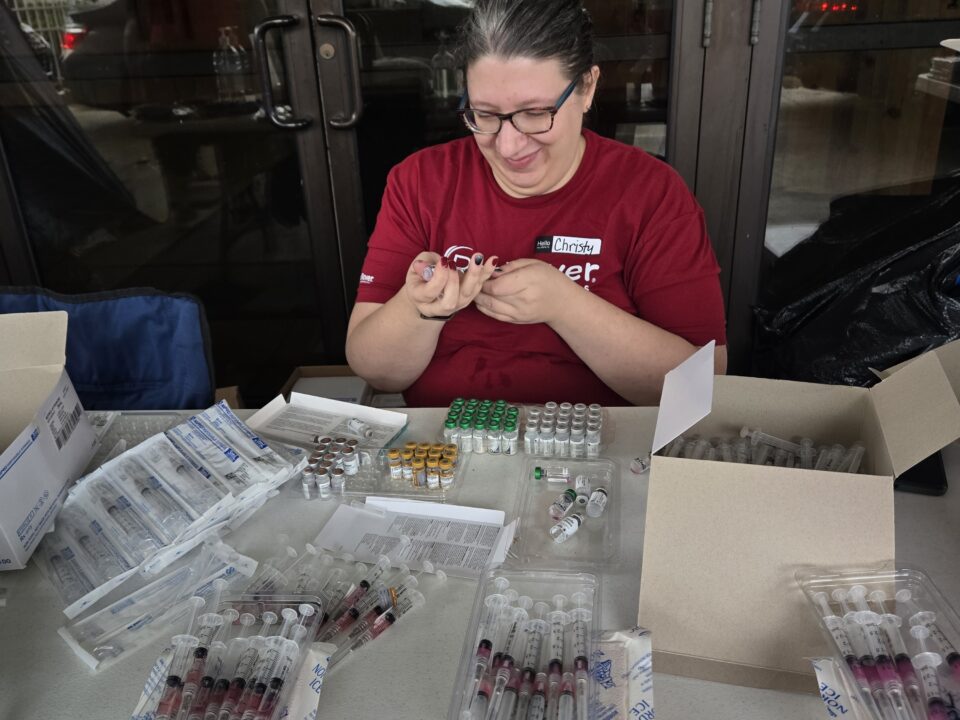Preschoolers learn how "Ginger Finds a Home"
May 6th, 2013
Written by Nicole Forsyth, RedRover President and CEO
 This Spring, I visited a preschool and used the RedRover Readers curriculum for the book Ginger Finds a Home, adapting it for children ages two to five. Typically the target age for our program is eight- and nine-year-olds, but children as young as two or even younger can begin to practice empathy.
This Spring, I visited a preschool and used the RedRover Readers curriculum for the book Ginger Finds a Home, adapting it for children ages two to five. Typically the target age for our program is eight- and nine-year-olds, but children as young as two or even younger can begin to practice empathy.
Here’s what I did. Try this with the young children in your life or pass this idea on to a teacher!
First, I greet the children and tell them, “Look around the circle at all your friends.” I then add, “Most of you know everyone’s names, and you know a lot about each other.”
“Does anyone remember what it was like when you first came here and didn’t know anyone’s name or much about them?” Some hands go up. “How did you feel?”
“Scared,” one student responds.
 “I didn’t know anybody’s name,” responds another.
“I didn’t know anybody’s name,” responds another.
“I didn’t want to come to school,” a child adds.
“Well, today, we’re going to learn about a girl and a cat who meet each other and then get to know each other,” I explain.
“Take a look at the cover. The title of this book is Ginger Finds a Home. Who is Ginger?” I ask.
“The cat!” shouts out one child.
“What else do you see on the cover?” I ask.
“Trash cans!” calls out another child.
“What do you think this book is going to be about?” I ask.
“Ginger finds a home where she’s taken care of,” says a student.
“Ginger meets a girl, and they get to know each other,” says another.
“Ok, let’s find out what happens,” I say.
Once there was a little orange cat who lived in a patch of weeds at the end of a garden. His ears were black with dirt. He was very thin. His fur stuck out. His tail was like a piece of string. He drank water from puddles. He looked in trash cans for things to eat. Every day he searched for food, and every night he went back to his patch of weeds to sleep. Then one day everything changed. The little cat had found only a bit of bread to eat and he was cold and hungry as he came back to his patch of weeds. He stopped. There on the ground was… a plate of delicious cat food. He couldn’t believe his eyes! He gobbled it up and went to sleep. He had never slept so well! The next night, he found another plate of food waiting for him… and something else. A little girl! “Hello,” she said. She tried to stroke his fur, but he was frightened and ran to hide in the weeds.
“Why do you think Ginger was frightened?” I ask.
“He didn’t know the girl,” responds one child.
“He was afraid of what the girl would do,” responds another.
I continue,
“See you tomorrow,” said the little girl.
She came to visit him every day. She brought him nice things to eat. She called him Ginger.
At this point I notice a few faces light up and some sounds like “aww.”
“Now she knows him,” says one of the children.
Some of the older children are understanding the concept of how names help you get to know someone more than I even thought they would. Seeing children make connections like this is incredibly rewarding.
I continue,
Soon Ginger looked forward to seeing the little girl. He came when she called, and when she stroked him, he purred.
 “What does it mean when a cat purrs?” I ask.
“What does it mean when a cat purrs?” I ask.
“Happy!” calls out a student.
I go on to read,
The little girl loved Ginger. “Ginger, “ she said, “you can’t stay here. Why don’t you come home with me.” So Ginger followed the little girl home. He had never been in a house before.
“How do you think he is going to feel?” I ask.
“Scared,” responds a child.
“Why do you think he’ll feel scared?” I ask.
“He’s never been in a house; he doesn’t know it,” answers another.
I continue,
He looked in all the corners and under all the furniture. But poor Ginger was so nervous… that when the little girl tried to shut the door, he ran out into the garden as fast as he could. The little girl looked outside. She couldn’t see him anywhere. “Ginger!” she called. But Ginger didn’t come.
“How does the girl feel?” I ask.
“Sad,” responds a student.
I read,
“I’ve frightened him away,” she said. “He doesn’t want to live with me. The little girl was very sad. She was so upset she didn’t notice… when Ginger came creeping back in. “Meow!” said Ginger. “Ginger!” said the little girl. Now Ginger lives with the little girl in her house. He is a very happy cat. And the only time he ever goes back to the patch of weeds at the end of the garden…is to sunbathe!
“Why do you think Ginger is happy now?” I ask.
“He has food,” says one child.
“He has parents and someone to take care of him,” says another.
Once we finish the book we talk about what a cat looks like when he or she is scared, and we look back at the illustrations from the book that show this. A big benefit of working with preschoolers is you can get down on the floor – no questions asked – and be silly, and they get down right along with you. I get down on the rug and act like Ginger did when he stretched his neck very slowly towards the food, and I slink down close to the floor like when he was scared looking around the house. The children all join in, learning some cat behavior through role playing. When I ask, the children also add other things cats might do when they’re scared, like run away, back up or bite and scratch.
 Then I pull out my kitten puppet: a scared and shy kitten that will only come and sit in the kids’ laps if they are quiet and still. The children sit in a circle, and the kitten climbs into laps and purrs for those sitting quiet or backs up from those who aren’t. This is a lot of fun!
Then I pull out my kitten puppet: a scared and shy kitten that will only come and sit in the kids’ laps if they are quiet and still. The children sit in a circle, and the kitten climbs into laps and purrs for those sitting quiet or backs up from those who aren’t. This is a lot of fun!
Then I pull out some cat bowls. “What are these for?” I ask.
“Food and water,” a few students say at the same time.
Then I pull out a collar with a bell. “What’s this?
“A collar,” one responds.
“Why does it have a bell?” I ask.
“It makes a pretty sound,” answers one student.
“OK, why else might a cat wear a bell?” I ask.
“To keep the birds away,” responds another child. We could expand this conversation further, but I stick to the main focus for today: helping them understand what cats look like when they’re scared and nervous, how their behavior can affect a cat’s emotions and to practice feeling empathy for cats or anyone in a situation that is unfamiliar.
For the last activity, the kids work in pairs, one at a time, to role-play the part where the girl tries to give Ginger food. Some children act as the nervous cat and some kids act as the person trying to approach slowly to give the cat food. The children learn for themselves that sometimes they would just have to leave the food on the ground and come back later to try again. Some “cats” decide to trust the person and come right up to eat the food.
If you’re an educator who wants to learn the theory behind this curriculum, the questioning strategies designed to promote critical thinking, empathy and more, sign up for our next online training course.
Learn more about RedRover Readers by visiting www.redrover.org/readers.
The book used in this lesson is Ginger Finds a Home by Charlotte Voake, published by Candlewick Press in Cambridge, Massachusetts. Used copies of the book are available online. Look for it in your local library or encourage them to carry it if they don’t already!



